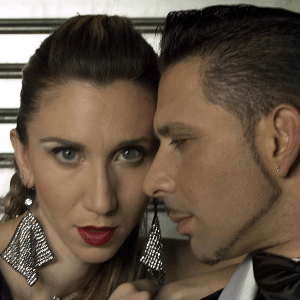You are dancing with your bones, not your muscles

by Dionisis Theodoropoulos and Chloe Theodoropoulou
Learn how to fix One of the biggest and most frequent mistakes that undermine the quality of the dance. You are dancing with your bones not your muscles.
One of the biggest problems that we face when we dance (or that we think that we face) is that we don’t have balance, that we don’t have a “good axis.” In reality, we all have an axis; our axis is simply our spine, which supports our body.
Dionisis’ and Chloe’s Five Steps Approach
The problem is that most dancers haven’t realized that if they correct their spine, they have automatically fixed their axis.Ignoring this, beyond the result of losing balance, often leads to one of the biggest and most frequent mistakes that undermine the quality of the dance. When the spine is not in the right position, our body is forced to intensively use its muscles, tendons, and joints to maintain our balance and posture. And this creates pain, unnecessary tension, and loss of dance quality. Let’s see how we can solve this.
You are dancing with your bones not your muscles
- First Step – Find the right spine position
- Second step – Remove bad habits
- Third step – Explore the power of simple repetitions
- Fourth step – Looking good helps you feel good
- Fifth step – Get the sensation into the embrace

First step – Find the right spine position
Try for a few seconds the following: imagine that you want to elongate the back part of your body, creating space for the one vertebra to stay on top of the other, without canceling though its natural -and useful- curves of the spine. This way, you have brought the most crucial ingredient of your skeleton (your spine) in the position which, according to the biomechanics of the human body, is built to function most efficiently and with the least amount of pressure or stress. There, muscles, tendons, and joints have a supportive role, and not the main one. Try it now, and focus on the sensation of your body in that position.
Second step – Remove bad habits
It is certainly difficult to remove bad habits. We all (some more, some less) live with “hurtful” habits to our body and our posture, which are not so easy to realize, accept, and correct. In this area, our experience has shown us that practicing in front of the mirror is very important, because when you can see your mistakes, you can correct them easier. When you don’t see it, you are only focusing on what feels right, not on what you see, and the correction might be insufficient, inaccurate, and lacking longevity. Repeat the previous step in front of a mirror (if possible, do it now).
Third step – The power of repetitions
Certainly, you know that it is quite hard, even when you have found it, to maintain the right position. Many times we realize what the right position is, but when the time for dance comes, we simply forget. The reason is that our body hasn’t absorbed the new information so it can use the right position automatically.
Here the solution is practice (focusing on quality, not quantity), but also the inclusion of the new, correct habit in everyday life. If you try, for example, to correct something in your position, make sure to create opportunities during the day, even for a few seconds, to practice it. This allows us to systematize the correct position, till we no longer need to put any big effort to reach the desired result.
When can you put your spine in the correct position during the day? Maybe when you wash your teeth, before getting out of the house, the moment you arrive at the office and you leave on the floor everything you carry, or any time that you wait in line for something. Define two moments that you are going to use during the week to realign your spine for ten seconds. Which moments make sense to you?
Did you define them? If no, really, stop reading and define them. If yes, then keep in mind to be persistent. Yes, for the first few days, you will often forget to do it. It’s normal. Gently remind yourself, and try again. And if you realized that you forgot, perfect, take ten seconds right there to focus on your spine. If it helps, add a post-it next to your door, or at the office to help you remember. Keep in mind: we are what we consistently do.
The realization about our spine is directly related to the first advice that we gave you: to be OK with the others, you need to be OK with yourself first. To hug the other, you should first hug yourself. And the awakening of your spine will help you achieve that: focusing on our spine, our body gets in the right place. When we correct our spine, we automatically highlight our positive elements and hide our negative.
For example, when your pelvis is forward, you seem to have a bigger belly and no waist. When you bring your attention to your spine, your pelvis gets in position, and so does the belly/center of your body. This way, a waist is “created,” and the curves are highlighted.
Fourth step – Looking good helps you feel good
Looking good helps you feel good. For us, the “aesthetically beautiful” and the “technically correct” go hand in hand. Where we are “beautiful,” we’ll also be “correct” and efficient. As we said before, by waking up our spine, we also awake our natural, vertical axis that goes through our bodies. This helps us stand straight, be grounded, and have balance.
If you want to understand the right position of your spine better, the following image can help. Imagine that a hand pulled you from the top of your spine, lengthening your neck, and letting your vertebrae fall on top of each other one by one, ending at the pelvis, which then “falls” heavy towards the earth, without tension on the hips and glutes. The sensation should be that you are hanging from a rope, flowing through space. Here, your bones are supporting you, and NOT your muscles, softening all the tension in the big muscle groups of your body.
Fifth step – Get the sensation into the embrace
We want to transfer the sensation we created in the fourth step into our embrace. Here, you should find each other, without losing the connection with your spine and your natural vertical axis, using the joints of your ankles to come closer to each other. One of the main problems that appear, because of the nature of our embrace, is that when we hug, because our focus is on the frontal contact, we forget what happens behind us.
Our experience has shown us that it is crucial to maintain first our connection with the back part (the spine) of our body when we are in the embrace. This way, we’ll also solve another big problem which often appears in tango: lack of space. By aligning your body, you are creating space for yourself and for your partner to come closer to you and be welcomed in the embrace. We invite you, the next time you hug someone, instead of focusing first on the front of your body, to focus on your spine. If you can, try it now, even if you have to hug a column or a bunch of jackets hanging from a circular hanger.
Remember, by bringing your attention to the back, and awakening your spine, you create space, putting the big parts of the skeleton (head, hips, etc.) in their position. You also remove unnecessary muscular tension, creating the conditions for a warmer and more receptive embrace. At the same time, you are making your dance less tiring and more efficient.
Dionisis Theodoropoulos and Chloe Theodoropoulou – from the book Tango Tips by the Maestros

Chloe Theodoropoulou & Dionisis Theodoropoulos – Greece
Dancers, teachers, and tango choreographers. Founders of TANGOPOLIS, the brand new tango hotspot in the heart of Athens, Chloe and Dionisis are a couple with a vast experience in teaching and performing. Technique, accuracy, authenticity, and elegance are the traits of their dance. Together they like to explore the limits and experiment with movement and music, creating intense dramatic elements while maintaining the communication and dialogue in their dance. For them, tango is a social dance, a way of expressing and communicating.

